by Carrie Stevenson | Jun 1, 2016
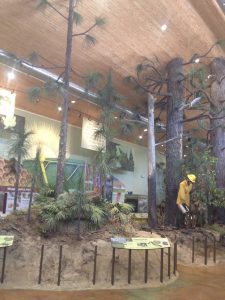
The longleaf forest display at the E.O. Wilson Biophilia Center shows typical vegetation and wildlife in the forest. Photo credit: UF IFAS Extension
Pine trees are so common in the southeastern United States that they are often taken for granted. They are usually the first to be cut down when homeowners are nervous about storms, and unless you’re in the tree-growing business, they are not considered all that valuable. However, the history and development of northwest Florida is intrinsically tied to the stately pine. During the 19th and early 20th centuries, the “naval stores” industry employed thousands of people collecting resin from pine trees. This industry produced turpentine and rosin used most famously to waterproof wooden ships, but also for soap, paint, inks, varnish, and medications.
Our area is home to seven native species, and each fulfills a specific role in the environment. In fact, during Florida Master Naturalist Program classes, we teach about pines living in all three of the broad Florida habitat types—uplands, freshwater wetlands, and coastal areas. These species can be difficult to tell apart, but a few tricks can help keep them straight.
The best way to keep track of pines is to recall that species starting with “S” (sand, shortleaf, spruce) have needles in bunches of twos (the letter S has two endpoints), and pines starting with “L” (a letter with 3 endpoints) have bunches of three (loblolly, longleaf). Finally, slash pine, starting with “SL” has bundles of 2-3 needles. Pond pine is an anomaly in that its shorter needles are in bunches of 3-5 needles.
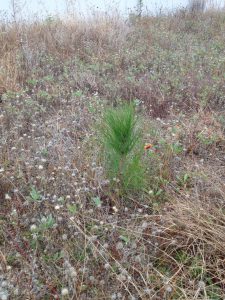
Longleaf pine sapling Photo credit: UF IFAS Extension
A few interesting facts on some of our native pine species:
- The Southeast was once covered in over 60 million acres of longleaf pine forests, the namesake of an ecological habitat that encompasses many valuable and endangered species, including bobwhite quail, red-cockaded woodpeckers, gopher tortoises, and indigo snakes. Wind resistant and adapted to frequent fires, the trees can grow 80-100 feet tall. One of the largest stands of longleaf pine in Florida is at Eglin Air Force Base.
- Pond pine often grows along the edges of wetlands and ponds. Its cones may stay closed on the tree for up to eight years, but if a fire comes through they will immediately open and release their seeds. This adaptation allows the species to take advantage of open soil in full sun after a fire to germinate new trees.
- Sand pine can grow in extremely sandy, low-nutrient soils, including beach dunes on the Gulf and Atlantic coasts. They have very short needles (2-3 inches long), and the “Choctawhatchee” variety of sand pine works well as a Christmas tree.
For detailed information on identifying all seven species along with several introduced pines, please see the new UF publication, “Common Pines of Florida.”
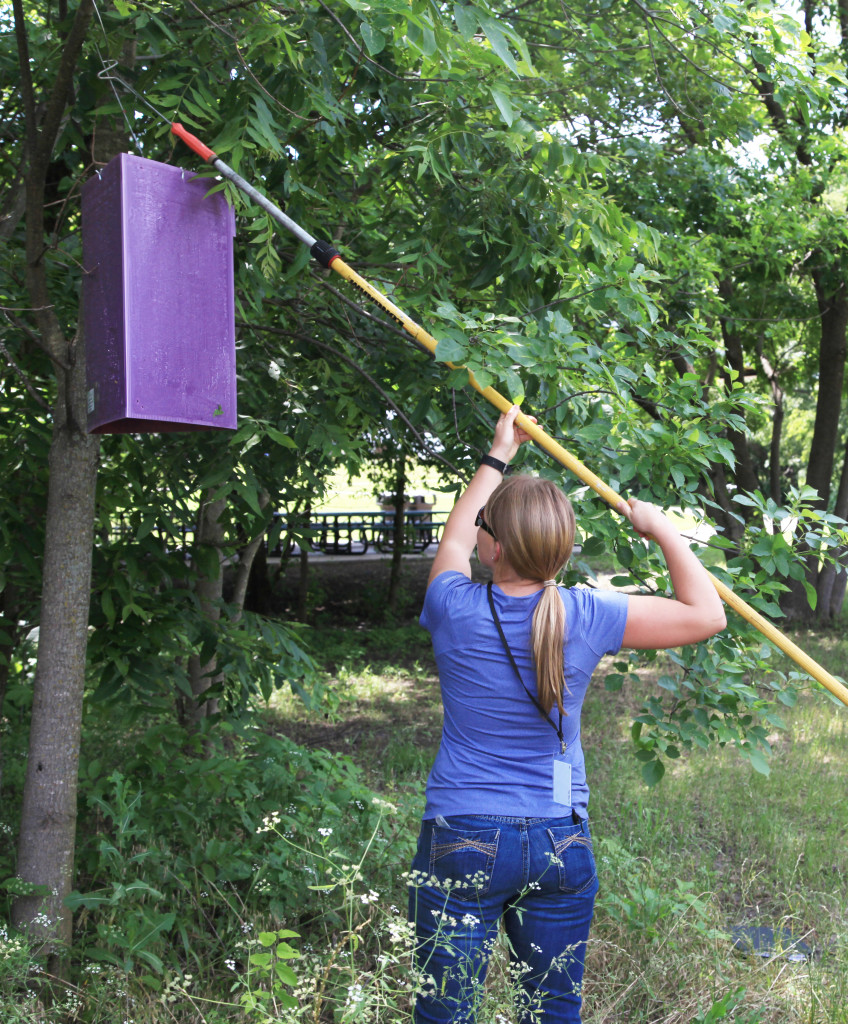
by Matt Lollar | May 24, 2016
From time to time I am reminded of how little I know. Honestly, I am reminded on a daily basis. A few weeks ago someone asked me about the purple things hanging from the trees. Luckily, the person gave me some good southern directions on where I could find one of these things hanging around in Marianna. So I drove out to the site to get a better look. What I saw hanging in the tree was a three-sided, purple triangle about two feet tall and a foot wide. It looked to me like someone got a box kite stuck in a tree. Upon further research, it was determined this box kite like thing was a monitoring trap for the emerald ash borer (EAB).
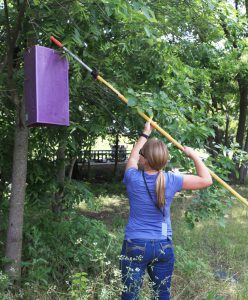
A woman hanging an emerald ash borer trap in a tree. Photo Credit: Texas A&M University
The emerald ash borer (EAB) is a destructive, exotic wood-boring beetle native to Asia. It was first discovered in North America in July 2002 and has made a home in Michigan, Ohio and Ontario, Canada. Millions of ash trees have been killed by the EAB in Michigan and invested ash tree nursery stock in other states indicates the potential for increased spread of the pest. EAB has made its way to the south and has been found in Louisiana and Arkansas.
Monitoring traps are not the only means of EAB detection. A proactive approach utilizing observant citizens can help keep an eye out for potential populations. You can use these tips to monitor your community for emerald ash borers:
Ash Tree Identification – Ash trees are identified by their (1) opposite branching pattern, (2) compound leaves with 5-9 leaflets, and (3) diamond shaped bark ridges on mature trees.
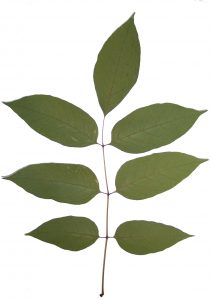
A compound leaf of an ash tree. Photo Credit: FDACS
Woodpecker Damage – Of course, not all woodpecker damage on ash trees is associated with EAB infestation, but woodpecker damage in the upper part of the tree can indicate their presence. The woodpecker damage is usually accompanied by vertical cracks in the bark.
Canopy Thinning – As the attack progresses, bark cracking continues and the canopy in the upper half of the tree begins to thin.
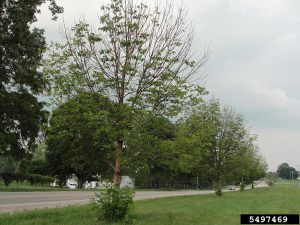
Michigan ash tree showing decline due to Emerald ash borer. Photo Credit: USDA
Tunnels and Holes – The emerald ash borer makes distinctive S-shaped tunnels that differ from damage from other borers.
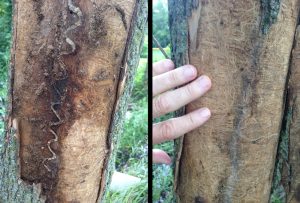
EAB Damage (left) VS Other Borer Damage (right). Photo Credit: Texas A&M University
This beetle hitchhikes on firewood and infests new areas at an alarming rate. Although the EAB has not yet been detected in Florida, transporting firewood from other states puts Florida ash trees at risk. Your help is needed to detect possible infestations so they can be quickly eradicated. The information available at the following links will help you identify the EAB, EAB host trees, and infestation symptoms.
by Sheila Dunning | May 19, 2016
As cities expand, wooded lands and property with mature trees are being developed into commercial and residential sites. Unfortunately, the construction process can be deadly to nearby trees. In most cases, the trees don’t die immediately. Several years later as symptom development occurs in the declining trees, most people don’t associate it with the previous construction.
However, it is possible to preserve trees on building sites if the right measures are taken. Trees and their root systems must be protected from damage during the construction process. Roots absorb the water and nutrients that are essential to tree health. Damage to the roots can lead to the death of a tree. Compaction of the soil from equipment operation can hinder the tree’s absorption of nutrients.
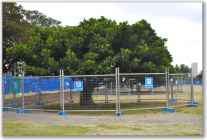 The single most important action is to set up sturdy construction fences around the tree. The fence should be placed at least at the dripline of the tree’s canopy. As a general guideline, allow 1 foot from the trunk for each inch of the trunk diameter. Even with this method, 50% or more of the roots will be impacted by construction. No vehicles, building materials, waste, or soil should be allowed within the fenced area. No digging, trenching, or soil disturbance should be performed in that space. If construction equipment is allowed to operate close to the fencing, root pruning should be performed. A 4-5 inch deep trench should be dug on the outside of the tree protection zone with an air spade and then cut the roots cleanly with a saw. This root pruning technique will limit extensive damage to the roots.
The single most important action is to set up sturdy construction fences around the tree. The fence should be placed at least at the dripline of the tree’s canopy. As a general guideline, allow 1 foot from the trunk for each inch of the trunk diameter. Even with this method, 50% or more of the roots will be impacted by construction. No vehicles, building materials, waste, or soil should be allowed within the fenced area. No digging, trenching, or soil disturbance should be performed in that space. If construction equipment is allowed to operate close to the fencing, root pruning should be performed. A 4-5 inch deep trench should be dug on the outside of the tree protection zone with an air spade and then cut the roots cleanly with a saw. This root pruning technique will limit extensive damage to the roots.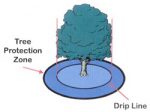
The next step that will help the survival of a protected tree is irrigation during the construction phase. Stressed trees need plenty of water throughout the process. This means watering each tree about 2-3 times per week to a soil depth of 4-6 inches. Additionally, an application of 3 inches of organic mulch within the tree protection zone would help maintain soil moisture. But, do not place mulch against tree trunks because it could cause fungus growth to the trunk. If roots are not pruned at the edge of the protection zone, mulch should be placed over any roots that could possibly be driven over to reduce compaction.
Following construction the fencing can be removed, but irrigation needs to continue. However, the frequency should be reduced while the duration needs to be increased, to ensure that the tree receives enough water to maintain moisture in the top 12-18 inches of soil for the next year.
Simply keeping a tree on site does not mean it will survive the construction process. If measures to protect the tree cannot be taken, the most practical approach is to remove the tree prior to construction. But, for some of the historical mature trees it is probably worth the effort to preserve some horticultural heritage of the area.

by Daniel J. Leonard | Apr 27, 2016
People are, by nature, skeptical. Humans are and have always been questioners of the world around them and that’s a good thing! For instance, when one reads a sensational article on Facebook or watches an infomercial selling a too-good-to-be-true product he/she is immediately dubious of the veracity of the claim. Given this innate sense, why do consumers take plant tags displayed on retail plants and the information listed there as infallible fact when in reality they are often full of hyperbole and misleading?
I do not mean to insinuate that nurseries and landscape professionals are intentionally leading consumers astray. They are not. However, there is much incorrect information disseminated to consumers by the green industry on plant fact sheets. Take my titular example, ‘Little Gem’ magnolia is widely advertised and sold as a “dwarf” magnolia, only growing 15’-25’ tall. If given proper care, it will grow to that height…in seven to ten years. Given enough time, ‘Little Gem’ has will grow in excess of forty feet. People plant this cultivar under the eaves of single story houses on a regular basis! I promise that cute little magnolia you were told would grow 15’ tall will look rather silly when it is four times the height of your house. Take another example, how many times have you seen or heard of ‘Acoma’ crapemyrtle being sold as a “semi-dwarf” cultivar that grows to 10’ in height for use in a tight spot of the landscape in lieu of the much larger ‘Natchez’? It will fill that tight spot and fill it rather quickly. ‘Acoma’ can easily reach 20’ in height and width at maturity, engulfing its intended area.
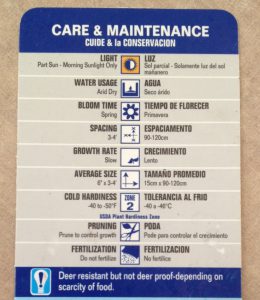
Typical plant tag. Notice the “Average Size” section. This is where consumers should use discretion.
So why does this happen? Why are plant tags so often mistaken? There are two primary reasons that correct mature sizes are not given. First, in the competitive world of plant breeding and introduction where there can be hundreds or thousands of cultivars of a single species, it is of utmost importance to introduce plants as quickly. Quick introduction is necessary because others are probably working to find similar traits; therefore, if one notices that a plant possesses a drastically different flower, flowering pattern, leaf shape, leaf size, or growth habit, the plant is often rushed to market. This leaves little time for complete trials of the plant to see what it would look like at maturity.
Secondly, most well-adapted or native trees/shrubs have relatively long life spans. A crapemyrtle or magnolia can easily grow and thrive in a landscape for thirty years or more before reaching maximum size. Nurseries simply do not have time to evaluate plants that long. Many nurseries, due to vagaries of economic cycles and length of career spans, don’t even exist for thirty years much less trial a single plant for that length of time!
In conclusion, nurseries are not likely to change their plant tag practices, but there are a couple of checks consumers can use to make sure they buy an appropriate plant for the scale of their site. First, it is a good rule of thumb to double the advertised plant height to arrive at a better idea of the plant’s mature size. Second, drive through established neighborhoods and observe what certain plants look like in a mature landscape. This will give one an idea of what the plant is capable of. The third and best option is to consult your local County Extension Office. They will be able to offer research-based information to help you make the right decision in your plant choices. Keep this in mind the next time you are thinking of buying the latest, greatest plant at your local nursery!
Happy Gardening!

by Mary Salinas | Apr 21, 2016
Recently, a home gardener brought in some strange looking new leaves on his camellia. The youngest leaves were thick and fleshy and looked more characteristic of a succulent type plant than a camellia. What’s wrong with these leaves?
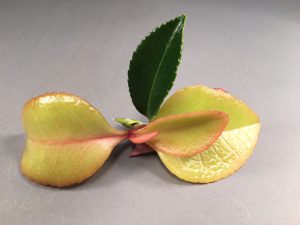
Camellia leaf gall infection resulting in fleshy light green and pink leaves. Note the contrast with a healthy uninfected leaf. Photo credit: Mary Derrick, UF/IFAS.
The culprit is a fungus Exobasidium camelliae whose spores are carried by the wind in search of camellias. This fungus infects camellias, especially sasanquas; it will not infect any other plant species. The disease it causes is known as camellia leaf gall and is most commonly seen here in the Florida panhandle in April. The frequent wet weather this winter and spring created favorable conditions for disease development.
The symptoms of the disease are easy to distinguish and really stand out against the typical dark green leaves of the camellia. Leaves become thick and fleshy and the color ranges from light green to cream to pink. As the disease progresses and the galls mature, the lower leaf surfaces of the leaves will peel away to reveal a white underside laden with fungal spores. Wind and rain will take these new spores to other parts of the camellia or other camellias in the vicinity where they will lay dormant and cause infection the following spring. Eventually the galls will turn brown and dry up.
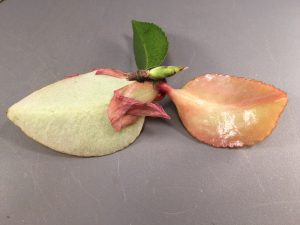
The underside has pealed away revealing white fungal spores. Photo credit: Mary Derrick, UF/IFAS Extension.
Camellia leaf gall is not a serious disease that requires chemical intervention for the homeowner. Simply remove the galls and put them in the trash. The earlier you remove the galls the better; the risk of further infection can be reduced if the galls are removed before the undersides peel and expose their spores. Any that have fallen to the ground can spread the disease and need to be removed.
For more information:
Camellias at a Glance
Camellia Leaf Gall
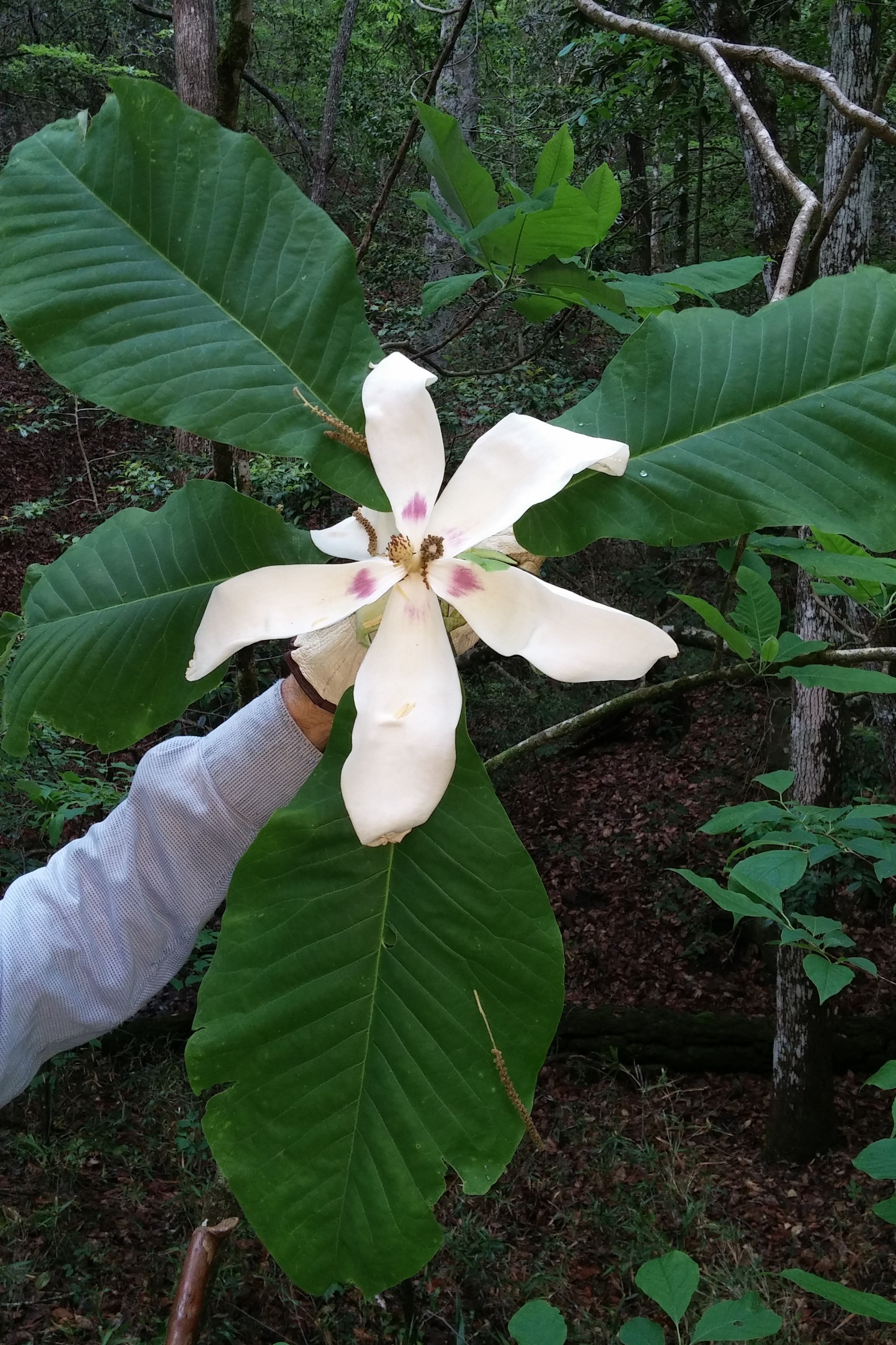
by Gary Knox | Apr 20, 2016
The huge flowers and leaves of Ashe magnolia make it one of my favorite native flowering trees. Individual flowers may be 6 – 12 inches in diameter and are white with purple blotches at the bases of the 3 inner petal-like tepals. When in flower, as they are now in April, the huge white blooms are impossible to miss because of their size and color.
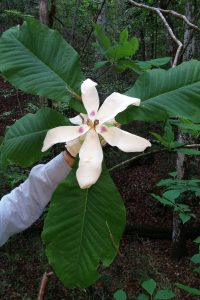
Ashe magnolia. Photo credit: Gary Knox, UF/IFAS.
The leaves are similarly huge, growing 1 – 2 feet long and up to 1 foot across. These large, banana-like leaves offer interest and coarse texture to any landscape.
Ashe magnolia grows as a small tree with a loose, open branching habit up to a height of about 25 feet. The large, light green leaves have whitish undersides and emerge in mid spring prior to flowering. Leaves turn yellowish and fall in autumn, usually without any dramatic color change. Pollinated flowers are followed by reddish, cylindrical, 3-inch fruits producing bright red fleshy seeds in early August.
Native to the Panhandle. This small tree is relatively unknown because of its rarity. Ashe magnolia, Magnolia macrophylla var. ashei, is native in only a few counties in the Florida panhandle and is endangered because of this limited distribution. It is primarily found on the slopes of ravines, growing in the understory of mixed hardwood forest. While it is now illegal to remove this plant or its seeds from the wild, nurseries can grow this plant using seeds from long-cultivated landscape trees.
Garden cultivation. Ashe magnolia makes a lovely small flowering tree if planted in the right location. It grows best in rich, well-drained soil under partial shade, although full sun is tolerated if plants are irrigated during drought. Sheltered sites are best since strong winds can shred the papery leaves and break the brittle branches. You won’t have to wait long for this plant to flower; a unique aspect of Ashe magnolia is that it flowers when young, reportedly when as small as 1 foot tall! Another unusual characteristic is that this Florida native plant is hardy north into USDA plant hardiness zone 6.
Given this species’ beauty, rarity and nativity to the Panhandle, I think it is almost an obligation for panhandle Floridians to cultivate and showcase this plant in our gardens while preserving it in our forests! Seek out specialty nurseries to obtain one of these rare beauties for your garden.
For more information:
Atlas of Florida Plants: Ashe Magnolia
Ashe Magnolia at the United States Botanic Garden
USDA Ashe Magnolia Plant Profile
















